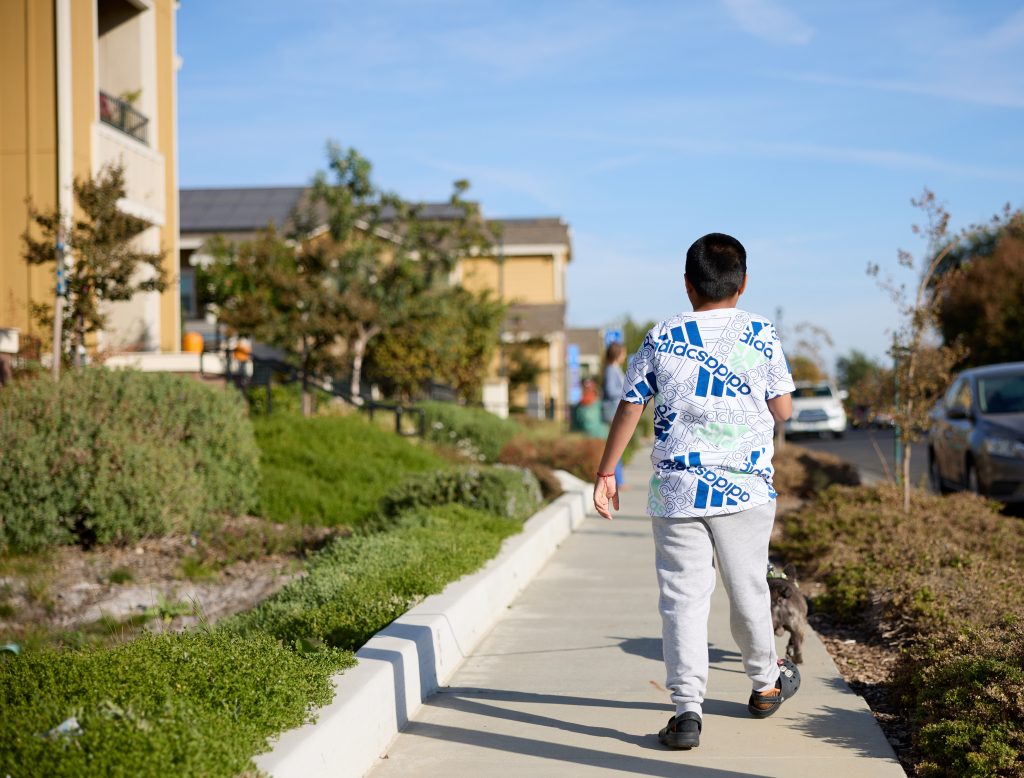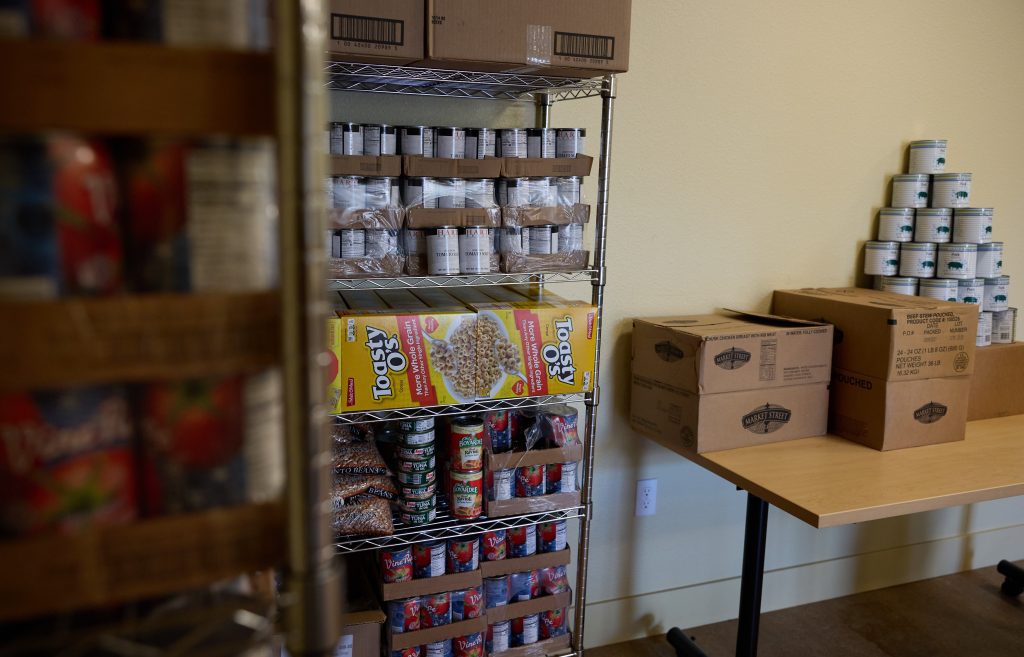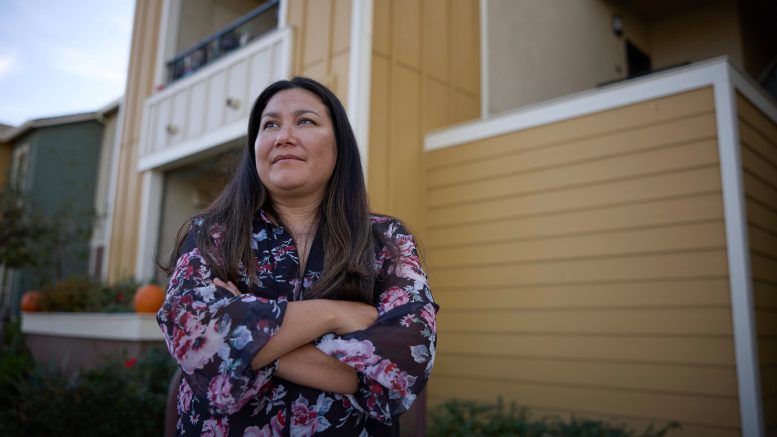Law now mandates the first statewide study of farmworker housing conditions, needs and solutions
By Jennifer Junghans
When Tonia Ochoa, an agricultural worker in Woodland, arrived in the United States from Colima, Mexico with her two children, she took the first apartment she could find.
The building was old, the living conditions were poor, and the gas, water and electricity frequently didn’t function properly. Her home was a constant source of stress. The rent ate up half of her $1,800 monthly income and people hung around outside all hours of the night in her densely populated neighborhood, making her feel unsafe when she had to leave for work in the early morning hours. She endured the stress of her living conditions for three years.
Then in 2019, she saw an advertisement at her local laundromat for Mutual Housing at Spring Lake, a colorful, new year-round permanent apartment complex exclusively for farmworkers. And it was seamlessly integrated into the city of Woodland’s Spring Lake Specific Plan, a residential development of more than 4,000 homes with parks, schools, businesses, community amenities and access to public transportation and municipal services — many within walking distance.
“Like other people, I thought that it would be very difficult to come and apply, and that it would be very delayed, that it was going to take a lot of time and they might not accept me because I worked such little time at the farm,” Ochoa said via a translator.
But she knew someone who lived in the complex who told her the application process wasn’t difficult, that she qualified and should apply. She assured her she would be accepted. And in May 2019, she was.
The need to build more housing like Mutual Housing at Spring Lake is entering into California’s response to its housing crisis. In September 2022, Gov. Gavin Newsom signed a housing package, including Assembly Bill 1654, to help address the shortage. The legislation ushers in a historic step toward equitable farmworker housing by mandating the California Department of Housing and Community Development (HCD) to conduct the first statewide study “of farmworker housing conditions, needs and solutions.”
Becoming part of the larger neighborhood

Today, Ochoa’s old apartment building sits empty, scheduled for demolition. She and her teenagers are one of 100 farmworker (active and retired) households living at Mutual Housing at Spring Lake who make up to 60% of the region’s median annual income of $78,386. Residents only pay 30% of their income for rent, regardless of the ebb and flow in income that follows the agricultural seasons. The U.S. Department of Agriculture Rural Development Rental Assistance Program subsidizes each unit’s rent for the next 55 years. But the economically inclusive housing development is more than a roof over their heads.
The complex features landscaping, a playground, community gardens, art by local artists, a community center, computer lab, food pantry and laundry facilities. On-site staff coordinate community activities and events that promote health, financial and academic education, leadership and community engagement.
The vision is to enable residents to be self-sustaining and independent, to be a part of the larger neighborhood and have the confidence to be leaders of positive changes in their community for themselves and future generations, said Vanessa Guerra, director of housing development for Mutual Housing California who worked in Yolo County’s agricultural fields as a child.
Aligning with the city of Woodland’s General Plan to design energy-efficient homes and subdivisions, Mutual Housing at Spring Lake is the first rental complex in the nation to be net-zero energy certified by the U.S. Department of Energy through the Zero Energy Ready Homes program, which means it’s designed to produce the equivalent of the energy used. The complex won the Housing Innovation Award by the DOE in 2015 and 2020 for the first and second phases of development, respectively.
Guerra says the catalyst to developing the net-zero property came directly from outreach efforts to include farmworkers in the design of housing that would meet their needs. Lower utility rates were a priority on the heels of lower rent.
Paired with energy-efficient measures within the units and education for residents on how to maximize energy-efficiency, the solar panels throughout the complex can eliminate or significantly reduce residents’ utility bills to as little as $10 a month. For Ochoa, the cumulative savings allow her and her children to travel to Mexico for much anticipated family visits.
Supporters of the housing development say it’s a model of what can be accomplished when local governments and nonprofits dedicated to developing affordable, sustainable housing work together. It serves as an example of success for other jurisdictions that haven’t or are resistant to integrating affordable housing for farmworkers into their communities.

Little is known about the demographics of farmworkers and how many reside in California remains a ballpark figure. The Center for Farmworker Families estimates between 500,000 and 800,000 live in the state, accounting for one-third to one-half of all U.S. farmworkers. It’s estimated an additional 400,000 children work in agricultural fields across the country.
“We don’t know how many affordable units are needed by the population. We also don’t know about farmworkers’ preferences … what kind of housing [they] would like to live in. Do they want to live near the farm? Do they want to live in urban places? How many are living in overcrowded conditions? How many are living in substandard housing?” said Rob Wiener, executive director of California Coalition for Rural Housing. “The sense is that we’ve made a lot of progress but still there are lots of farmworkers living in squalid conditions and the need is much greater than the supply.”
Following the study, the bill calls for the development of a comprehensive strategy to meet the housing needs of California’s farmworkers. And it gives teeth — even if they’re baby teeth — to those efforts by designating up to $25 million in low-income housing tax credits annually between 2024 and 2034 to develop farmworker housing. But the funding depends on the Budget Act that determines if the annual allocation of up to $500 million in low-income housing tax credits — the source of the $25 million in tax credits — is available first.
When it is, Wiener said it will go to the Low-Income Housing Tax Credit Program, which is allocated funds by the California Tax Credit Allocation Committee. All developers — nonprofit and for-profit — can compete for the tax credits through a competitive proposal process and then sell the credits to investors to secure funding.
But not all municipalities and counties want affordable housing integrated into their communities, even though it meets the needs of many populations beyond farmworkers, including seniors, first-time homebuyers and essential workers, Wiener said. There are still stigmas associated with affordable housing, he added, such as traffic congestion, impacts on schools, increases in crime and decreasing property values.
But the city of Woodland thinks differently and its Affordable Housing Ordinance requires 5% to 10% of all new units constructed to be available to all populations of low-income renters and buyers, said Erika Bumgardner, business development liaison for the city of Woodland. In fact, its Housing Element promotes lifecycle housing, which functions on the premise that “diversity in housing stock and affordability accommodates the diverse needs of the population” and “creates its own demand as families move up through the market.”
That’s how the city’s Housing Element defines the design of the Spring Lake development, with “a wide range of housing types, densities, sizes and affordability, including very high end estate-style housing and housing for very low income households as well.”
Roughly 6,000 residents in Yolo County are farmworkers, like Ochoa, who plants chiles, tomatoes, eggplants, cabbage and grapes; harvests tomatoes and chiles; and operates machinery to produce almonds, walnuts and pistachios. During the peak of the summer, she works 12- to 14-hour days in the heat, seven days a week. At the end of a grueling work day, she said she feels great comfort in knowing that when she comes home to her apartment at Mutual Housing at Spring Lake, everything will be fine.
Woodland is one of 239 California jurisdictions among 482 municipalities that have some form of inclusionary housing program. “Spring Lake is a good example of the city partnering with local advocates and housing developers to support farmworker housing in the community,” Bumgardner said.
Guerra echos that. “One of the biggest challenges our properties or our communities face when we’re in the development phase is sometimes a lack of local support. Thankfully here, we had a lot of local support.” The city invested $2.4 million to develop the property, one of 10 different funding sources needed to complete the two-phase, $36.2 million project.
To build local support, Mutual Housing California welcomed and engaged the community at large. Resources at Mutual Housing at Spring Lake are designed to benefit everyone who lives in Woodland, not just the farm-working residents living in the complex. For example, the community center is available as a meeting ground for citywide gatherings, such as a neighborhood watch program. And the food pantry is available to anyone living in the city of Woodland.
“We’re really part of the entire community,” said Guerra. When you’re able to demonstrate models like these, that this is a well-received community, you show people that it’s not this big, scary thing everybody thinks it is, she said.
Mutual Housing of California is actively working to build 1,000 more units of safe, affordable housing — including farmworker housing — in Northern California by 2026. “We’ve been in conversations with other jurisdictions within the county who are interested in replicating this model and providing more housing for the farmworkers here in this area,” said Guerra, who adds the additional funding from AB 1654 will serve as another source of capital to leverage.
But cracking the funding code is a perennial thorn in developing safe, affordable housing for farmworkers. And while funds from AB 1654 are an important incremental step forward to assemble the mosaic of necessary funding, $25 million doesn’t even cover the cost of a single housing development such as Spring Lake.
In Woodland alone, the city identified 265 units lacking complete kitchens and 90 units lacking plumbing facilities, with an estimated 1,537 units that may be dilapidated that were built before 1939. It also found 7.2% of its total housing units are overcrowded and roughly 2% are severely overcrowded, according to its 6th Cycle Housing Element.
But under the Regional Housing Needs Allocation, the state designates a number of low and very-low income housing units to be built over an eight-year period, which are then further allocated across a region’s local jurisdictions. But the number of required units is low. For example, the city of Woodland must provide land inventory and a regulatory environment to build 1,062 of these units between 2021 and 2029 as assigned by the Sacramento Area Council of Governments.
With 189 units currently in the pipeline and its pro-affordable housing approach with measures such as increasing housing density and streamlined permitting processes, the city projects a capacity of 1,087 units by 2029. Land for an additional 279 units would be available under the Woodland Research and Technology Park Specific Plan that is expected to be adopted later this year. While the city exceeds its obligation under the Regional Housing Needs Allocation, its assigned figure through 2029 is still less than its estimated dilapidated units existing today.
‘More places like this’

With hundreds of thousands of farmworkers living in California and many of them in need of safe and affordable housing, how do we reconcile supply and demand?
In 2018, the California Coalition of Rural Housing and the California Institute for Rural Studies conducted the Farmworker Housing Study and Action Plan for Salinas and Pajaro Valleys, which found more than 45,500 additional housing units were needed to address the extreme overcrowding and substandard living conditions for that region’s more than 90,000 farmworkers. The study proposes 57 solutions across housing types, suitable housing sites, funding solutions and regulatory reform, theoretically offering countless combinations of solutions to house the people who produce America’s food.
Wiener acknowledges some of the recommendations are transformative and would require a lot of political will. “If you have the people who somehow support that — local constituents — then this is essentially what you need for political will,” he said. “In my view you also need penalties. You need carrots and sticks.”
For example, he said of the Regional Housing Needs Allocation, “There’s not enough teeth in the law. So if you don’t comply, unless you’re sued by a legal services group, then there are very soft penalties.”
One solution Wiener is working to push through legislation is land value recapture. When fallow agricultural land due to marginal productivity is rezoned for residential use, it reaps some of the highest land values. Wiener wants some of that to be shared with the public sector. In exchange for benefiting from the conversion of land and the ensuing market rate housing, Wiener proposes owners be required to dedicate a portion of the land that’s contiguous to existing neighborhoods with commercial services and infrastructure for farmworker housing. It’s a common sense solution, he said.
And one that could serve various models of farmworker housing considered best practices by the California Coalition for Rural Housing. For example, integrated housing into established neighborhoods, mixed-generation housing that supports the community’s needs from child care to elder care and modular housing developments to speed up construction and reduce costs.
Others include affordable housing through community land trusts and mutual self-help housing where farmworking families build each other’s homes, investing sweat equity as a down payment. And there’s the Mutual Housing at Spring Lake model that is not just affordable but integrated into the community, energy-efficient and designed to improve the overall well-being of people.
“I think there should be more places like this for people who need it,” Ochoa said. “There are people who live two or three families in an apartment all together. … Or they live in very old apartments that have their roofs cracked and they get wet when it rains.[They] have many difficult situations and even more so when they have children. It makes me very uncomfortable.”
But at Spring Lake, she said, “You feel a pleasant atmosphere, people are friendly and you live well. … We are quite comfortable to be honest.”
This story is part of the Solving Sacramento journalism collaborative. Solving Sacramento is supported by funding from the James Irvine Foundation and Solutions Journalism Network. Our partners include California Groundbreakers, Capital Public Radio, Outword, Russian America Media, Sacramento Business Journal, Sacramento News & Review, Sacramento Observer and Univision 19.



Be the first to comment on "After Woodland leads the way, region looks to build more year-round affordable housing for farmworkers"